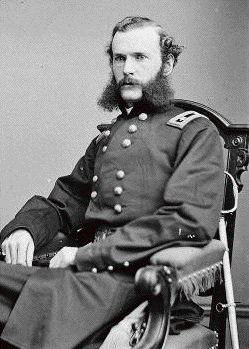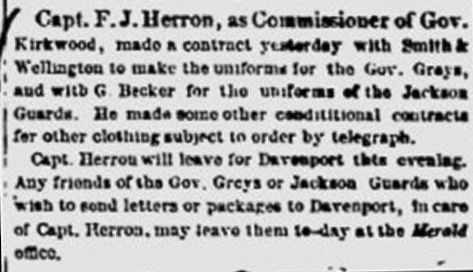Encyclopedia Dubuque
"Encyclopedia Dubuque is the online authority for all things Dubuque, written by the people who know the city best.”
Marshall Cohen—researcher and producer, CNN
Affiliated with the Local History Network of the State Historical Society of Iowa, and the Iowa Museum Association.
HERRON, Francis J.: Difference between revisions
No edit summary |
No edit summary |
||
| Line 1: | Line 1: | ||
[[Image:herron.gif|left|thumb|150px|Francis J. Herron]]HERRON, Francis J. (February 17, 1837-New York, Jan. 8, 1902). [[MEDAL OF HONOR]] recipient, Lieutenant Colonel, 9th Iowa Infantry. One of Dubuque's two Medal of Honor recipients in the [[CIVIL WAR]], Herron | [[Image:herron.gif|left|thumb|150px|Francis J. Herron]]HERRON, Francis J. (February 17, 1837-New York, Jan. 8, 1902). [[MEDAL OF HONOR]] recipient, Lieutenant Colonel, 9th Iowa Infantry. One of Dubuque's two Medal of Honor recipients in the [[CIVIL WAR]], Herron briefly attended the Western University of Pennsylvania, but left to become a bank clerk. In 1855, he moved to Dubuque, Iowa, where he opened a bank with his brothers. (1) | ||
[[ | In 1859, Herron formed a militia group called the [[GOVERNOR'S GREYS]] and offered the services of his unit to President-elect Abraham Lincoln. Although they were turned down, Herron and his men had the distinction of being the first troops to volunteer for the Civil War. In April 1861, the Governor’s Greys became part of the 1st Iowa Volunteer Infantry, and Herron was appointed as captain. The regiment saw service in Missouri, fighting with General Nathaniel Lyon’s troops in the battles of Boonville and Wilson’s Creek. (2) | ||
Herron was later exchanged for a Confederate officer and was promoted from lieutenant colonel to brigadier general. He continued his service to the Union for the remainder of the Civil War. | [[Image:fjherron.jpg|left|thumb|250px|Dubuque Herald, April 30, 1861. Image courtesy: Diane Harris]]Herron received his commendation for action on May 7, 1862, during the Battle of Pea Ridge, Arkansas. Herron was cited for gallantly leading his men in battle until he was disabled when his horse was killed, and he was captured. (3) | ||
Herron was later exchanged for a Confederate officer and was promoted from lieutenant colonel to brigadier general. He continued his service to the Union for the remainder of the Civil War. Herron was made commander of the 2nd and 3rd Divisions of the Army of the Frontier in Missouri, and in December of 1862, he further distinguished himself by coming to the aid of General James G. Blunt’s forces at the Battle of Prairie Grove, Arkansas. Herron and his men made a forced march of over 100 miles in three days to attack Confederate General Thomas C. Hindman’s troops and force them into a retreat. (4) For his quick and decisive actions, Herron was promoted to major general, becoming the youngest man to hold that rank at that time in the war. (5) | |||
By June of 1863, the Army of the Frontier was dismantled, and Herron led his division to join General Ulysses S. Grant in the siege of Vicksburg. After the fall of Vicksburg, Herron was one of three generals chosen to accept the formal surrender on July 4, 1863. (6) In 1864 he was appointed to the command of the District of the Frontier along the Rio Grande, River. (7) | |||
In the early 1890s Dubuque residents were angered when plans for a proposed soldiers and sailors monument on the Statehouse grounds in Des Moines did not include his likeness. See: [[HEALEY, George W.|George W. HEALEY]]. | In the early 1890s Dubuque residents were angered when plans for a proposed soldiers and sailors monument on the Statehouse grounds in Des Moines did not include his likeness. See: [[HEALEY, George W.|George W. HEALEY]]. | ||
[[SHIRAS, Oliver Perry|Oliver Perry SHIRAS]], George Shiras and Francis J. Herron were second cousins. Oliver & George Shiras's mother Eliza and Francis J. Herron where first cousins. | [[SHIRAS, Oliver Perry|Oliver Perry SHIRAS]], George Shiras and Francis J. Herron were second cousins. Oliver & George Shiras's mother Eliza and Francis J. Herron where first cousins. (8) | ||
The Shiras and Herron brothers all came to Dubuque around 1855 from the Pittsburgh area. George Shiras II (b.1806) married Elizabeth Perry Herron and had George Jr. (III) (b. 1832), Oliver Perry (b. 1833) and Francis Herron Shiras. Eliza Herron's (b.1809) father was Francis J. Herron's (b. 1837) uncle Rev. Francis Herron (b. 1774). Francis J. Herron's father was Francis Herron's brother and Francis J. Herron's uncle John Herron Jr. (b. 1792). Elizabeth Herron Shiras and Francis J. Herron's grandfather was also named John Herron Sr. | The Shiras and Herron brothers all came to Dubuque around 1855 from the Pittsburgh area. George Shiras II (b.1806) married Elizabeth Perry Herron and had George Jr. (III) (b. 1832), Oliver Perry (b. 1833) and Francis Herron Shiras. Eliza Herron's (b.1809) father was Francis J. Herron's (b. 1837) uncle Rev. Francis Herron (b. 1774). Francis J. Herron's father was Francis Herron's brother and Francis J. Herron's uncle John Herron Jr. (b. 1792). Elizabeth Herron Shiras and Francis J. Herron's grandfather was also named John Herron Sr. (9) | ||
Francis J. Herron also had a brother, David R. Herron, Lieutenant in the 3rd Iowa Light Artillery Battery, also known as the Dubuque Battery, organized in Dubuque. And besides Oliver P. Shiras serving as aid de camp to Br. Gen. Francis J. Herron during the Civil War, Herron had a nephew, James A. Herron, son of brother William A. Herron (b. 1821), who | Francis J. Herron also had a brother, David R. Herron, Lieutenant in the 3rd Iowa Light Artillery Battery, also known as the Dubuque Battery, organized in Dubuque. And besides Oliver P. Shiras serving as aid de camp to Br. Gen. Francis J. Herron during the Civil War, Herron had a nephew, James A. Herron, son of brother William A. Herron (b. 1821), who | ||
served on his staff. | served on his staff. (10) | ||
It should also be noted U.S. Supreme Court Justice [[SHIRAS, George Jr.|George SHIRAS, Jr.]] married Dubuque born Lillie E. Kennedy (b. 1842) daughter of Robert T. Kennedy (b. 1819). It appears Robert T. Kennedy and several of his children are buried in Dubuque. | It should also be noted U.S. Supreme Court Justice [[SHIRAS, George Jr.|George SHIRAS, Jr.]] married Dubuque born Lillie E. Kennedy (b. 1842) daughter of Robert T. Kennedy (b. 1819). It appears Robert T. Kennedy and several of his children are buried in Dubuque. (11) | ||
--- | --- | ||
| Line 20: | Line 24: | ||
Source: | Source: | ||
1. Moeller, Hubert L. "Iowa Generals in the Civil War," ''The Des Moines Register'', February 19, 1934 | 1. "Francis J. Herron," Civil War Trust, Online: http://www.civilwar.org/education/history/biographies/francis-j-herron.html | ||
2. Ibid. | |||
3. Ibid. | |||
4. Ibid. | |||
5. Moeller, Hubert L. "Iowa Generals in the Civil War," ''The Des Moines Register'', February 19, 1934 | |||
6. "Francis J. Herron." | |||
7. "General Herron," ''Dubuque Democratic Herald'', January 30, 1864, p. 4. Online: https://news.google.com/newspapers?nid=A36e8EsbUSoC&dat=18640130&printsec=frontpage&hl=en | |||
8. Geneology research by John Pregler | |||
9. Ibid. | |||
10. Ibid. | |||
11. Ibid. | |||
http://archiver.rootsweb.ancestry.com/th/read/HERRON/2005-12/1135815989 | http://archiver.rootsweb.ancestry.com/th/read/HERRON/2005-12/1135815989 | ||
Revision as of 18:54, 24 August 2015
HERRON, Francis J. (February 17, 1837-New York, Jan. 8, 1902). MEDAL OF HONOR recipient, Lieutenant Colonel, 9th Iowa Infantry. One of Dubuque's two Medal of Honor recipients in the CIVIL WAR, Herron briefly attended the Western University of Pennsylvania, but left to become a bank clerk. In 1855, he moved to Dubuque, Iowa, where he opened a bank with his brothers. (1)
In 1859, Herron formed a militia group called the GOVERNOR'S GREYS and offered the services of his unit to President-elect Abraham Lincoln. Although they were turned down, Herron and his men had the distinction of being the first troops to volunteer for the Civil War. In April 1861, the Governor’s Greys became part of the 1st Iowa Volunteer Infantry, and Herron was appointed as captain. The regiment saw service in Missouri, fighting with General Nathaniel Lyon’s troops in the battles of Boonville and Wilson’s Creek. (2)
Herron received his commendation for action on May 7, 1862, during the Battle of Pea Ridge, Arkansas. Herron was cited for gallantly leading his men in battle until he was disabled when his horse was killed, and he was captured. (3)
Herron was later exchanged for a Confederate officer and was promoted from lieutenant colonel to brigadier general. He continued his service to the Union for the remainder of the Civil War. Herron was made commander of the 2nd and 3rd Divisions of the Army of the Frontier in Missouri, and in December of 1862, he further distinguished himself by coming to the aid of General James G. Blunt’s forces at the Battle of Prairie Grove, Arkansas. Herron and his men made a forced march of over 100 miles in three days to attack Confederate General Thomas C. Hindman’s troops and force them into a retreat. (4) For his quick and decisive actions, Herron was promoted to major general, becoming the youngest man to hold that rank at that time in the war. (5)
By June of 1863, the Army of the Frontier was dismantled, and Herron led his division to join General Ulysses S. Grant in the siege of Vicksburg. After the fall of Vicksburg, Herron was one of three generals chosen to accept the formal surrender on July 4, 1863. (6) In 1864 he was appointed to the command of the District of the Frontier along the Rio Grande, River. (7)
In the early 1890s Dubuque residents were angered when plans for a proposed soldiers and sailors monument on the Statehouse grounds in Des Moines did not include his likeness. See: George W. HEALEY.
Oliver Perry SHIRAS, George Shiras and Francis J. Herron were second cousins. Oliver & George Shiras's mother Eliza and Francis J. Herron where first cousins. (8)
The Shiras and Herron brothers all came to Dubuque around 1855 from the Pittsburgh area. George Shiras II (b.1806) married Elizabeth Perry Herron and had George Jr. (III) (b. 1832), Oliver Perry (b. 1833) and Francis Herron Shiras. Eliza Herron's (b.1809) father was Francis J. Herron's (b. 1837) uncle Rev. Francis Herron (b. 1774). Francis J. Herron's father was Francis Herron's brother and Francis J. Herron's uncle John Herron Jr. (b. 1792). Elizabeth Herron Shiras and Francis J. Herron's grandfather was also named John Herron Sr. (9)
Francis J. Herron also had a brother, David R. Herron, Lieutenant in the 3rd Iowa Light Artillery Battery, also known as the Dubuque Battery, organized in Dubuque. And besides Oliver P. Shiras serving as aid de camp to Br. Gen. Francis J. Herron during the Civil War, Herron had a nephew, James A. Herron, son of brother William A. Herron (b. 1821), who served on his staff. (10)
It should also be noted U.S. Supreme Court Justice George SHIRAS, Jr. married Dubuque born Lillie E. Kennedy (b. 1842) daughter of Robert T. Kennedy (b. 1819). It appears Robert T. Kennedy and several of his children are buried in Dubuque. (11)
---
Source:
1. "Francis J. Herron," Civil War Trust, Online: http://www.civilwar.org/education/history/biographies/francis-j-herron.html
2. Ibid.
3. Ibid.
4. Ibid.
5. Moeller, Hubert L. "Iowa Generals in the Civil War," The Des Moines Register, February 19, 1934
6. "Francis J. Herron."
7. "General Herron," Dubuque Democratic Herald, January 30, 1864, p. 4. Online: https://news.google.com/newspapers?nid=A36e8EsbUSoC&dat=18640130&printsec=frontpage&hl=en
8. Geneology research by John Pregler
9. Ibid.
10. Ibid.
11. Ibid.
http://archiver.rootsweb.ancestry.com/th/read/HERRON/2005-12/1135815989
http://www.findagrave.com/cgi-bin/fg.cgi?page=gr&GRid=42719104
http://www.historycentral.com/Bio/rec/GeorgeShiras.html
http://www.findagrave.com/cgi-bin/fg.cgi?page=gr&GRid=42678583
http://www.findagrave.com/cgi-bin/fg.cgi?page=gr&GRid=33811968



